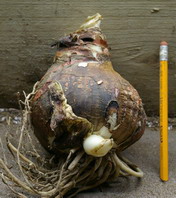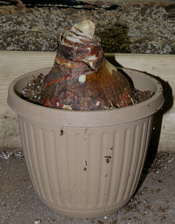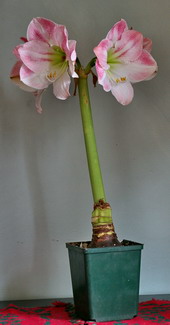|
I Have This Huge Amaryllis Bulb. Now What?
 The derisive laughter and comments about the giant onion, from their friends, died down after 2 - 3 weeks when the large flower stalk started to grow. Quite frequently a ruler would appear and be stuck in the pot so that the rapid growth could be measured and then when the enormous flowers opened my reluctant horticulturists were the envy of their floor and another generation of gardeners was born. They all still look around anxiously each Christmas to see where their Amaryllis bulbs are. This year the youngest was heard to proclaim that the best thing about having a boyfriend was that she then received two Amaryllis bulbs.
The derisive laughter and comments about the giant onion, from their friends, died down after 2 - 3 weeks when the large flower stalk started to grow. Quite frequently a ruler would appear and be stuck in the pot so that the rapid growth could be measured and then when the enormous flowers opened my reluctant horticulturists were the envy of their floor and another generation of gardeners was born. They all still look around anxiously each Christmas to see where their Amaryllis bulbs are. This year the youngest was heard to proclaim that the best thing about having a boyfriend was that she then received two Amaryllis bulbs. You can have as much fun and success with your bulb if you simply do as each of them did and then sit back and admire it. Can We Do It Over Again
Even when they were still at school, all of the Children started asking the same question that you will ask. This bulb was so big and flowered so beautifully, can we get it to flower again; because throwing it away would just seem to be such a waste? This is how those of us in the 'gardener's secret society', surreptitiously create new members. Give them one big easy success and they come back looking for more. Fortunately, it is really rather easy to get your Amaryllis to bloom again. Indoor gardening has never been so easy. The trick is to remember exactly what you are trying to do. That amazing flower was obviously stored in the bulb that you started with. How can you regenerate that bulb so that another flower bud is rebuilt inside it. The trick is to provide the Amaryllis with the energy to do the job. The bulb will start to grow leaves as it finishes flowering and those leaves will begin to regenerate the flower by absorbing
light, the green world's energy source.
As soon as any danger of frost has passed in your part of the world, put the potted Amaryllis outside in the full sun. Some people like to bury pot and all in the garden to decrease the need for water but you run the danger of having significant roots develop outside of the pot. Throughout the warm season you will have to water the pot quite regularly, probably at least once a week. To help turn all of the sun's energy into that new flower bud you should also develop a regular fertilizer program. Use an easily dissolved fertlizer such as 20 20 20 and just put the correct amount into every other watering. That's it for the summer. Lots of light and regular water and fertilizer. The final and crucial step is even easier. Before there is any frost, bring the pot with its several healthy long leaves indoors and put it into a cool dry spot in the house. It can and even should be in a dark part of the house. No water! After a few weeks you may want to tidy it up by taking off the now dry and brittle leaves but that's optional, they'll crumble and fall off the next time you move it. Keep it dry and cool, 55-60F., and ignore it until early winter. It will, at least it should, bloom again about 8 weeks after you bring it out of the basement. You probably won't need to repot it the first year. Just bring it into the warmth and the light and water it and then you can sit back and watch the miracle all over again. I can't explain why, but unlike the new bulb, it will probably start growing leaves as well as a flower stalk when you start the process. When it produces more and bigger flowers than last year, you are caught in a delightful trap. You are an indoor gardener! |
